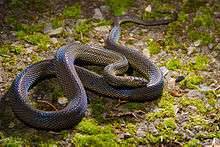Xenodermatidae
| Xenodermatidae | |
|---|---|
 | |
| Formosa odd-scaled snake, A. f. formosanus | |
| Scientific classification | |
| Kingdom: | Animalia |
| Phylum: | Chordata |
| Class: | Reptilia |
| Order: | Squamata |
| Suborder: | Serpentes |
| Infraorder: | Alethinophidia |
| Family: | Xenodermatidae Gray, 1849 |
| Genera | |
|
Six genera, see the text | |
| Synonyms | |
Xenodermatidae is a family of snakes from South, Southeast, and East Asia.[3][4] They are small or moderately sized snakes, never more than 80 cm (31 in) but typically less than 55 cm (22 in) in total length. They are secretive, probably nocturnal, and typically inhabit moist forest habitats. They seem to be opportunistic carnivores, preying on other vertebrates.[4]
It is argued that the correct spelling of the family name is Xenodermidae,[1][2] but, as of early 2016, the Reptile Database continues to use Xenodermatidae.[3]
Taxonomy and systematics
Xenodermatidae have a basal position in the colubroid radiation.[1] However, their exact position is not yet settled, e.g., they might be the sister taxon of the rest of Colubroidea,[4] or that their sister taxon is Acrochordidae, and that these two families together form a clade that is the sister taxon for the Colubroidea.[1]
Genera
The family consists of the following six genera:[3]
- Achalinus Peters, 1869
- Fimbrios Smith, 1921
- Parafimbrios Teynié, David, Lottier, Le, Vidal & Nguyen 2015
- Stoliczkia Jerdon, 1870
- Xenodermus Reinhardt, 1836
- Xylophis Beddome, 1878
References
- 1 2 3 4 Durso, Andrew (23 February 2016). "Dragonsnakes and Filesnakes Revisited". Life is Short, but Snakes are Long. Retrieved 27 February 2016.
- 1 2 Savage, Jay M. (2015). "What are the correct family names for the taxa that include the snake genera Xenodermus, Pareas, and Calamaria?". Herpetological Review. 46 (4): 664–665.
- 1 2 3 Xenodermatidae at the Reptarium.cz Reptile Database. Accessed 24 February 2016.
- 1 2 3 Vitt, Laurie J.; Caldwell, Janalee P. (2014). Herpetology: An Introductory Biology of Amphibians and Reptiles (4th ed.). Academic Press. p. 613–614.